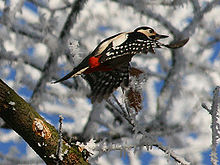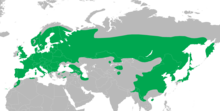Great spotted woodpecker
This is the sighted version that was marked on June 7, 2021. There is 1 pending change that needs to be sighted.
![]()
This article is about the bird species. For the band, see Pileated woodpecker (band).
The great spotted woodpecker (Dendrocopos major, Syn.: Picoides major) is a species of bird in the woodpecker family (Picidae). The small woodpecker inhabits large parts of northern Eurasia as well as northern Africa, inhabiting forests of almost every kind as well as parks and tree-rich gardens. Food is sought in all strata of the forest (except the forest floor), but mainly in the treetops. It consists of both animal parts and, especially in winter, plant material. The food spectrum is very broad and includes a wide variety of insects and other invertebrates as well as small vertebrates and bird eggs, seeds, berries and other fruits, and tree sap.
The species is common and the population is increasing, at least in Europe. The Great Spotted Woodpecker is therefore classified by the IUCN as "least concern".
Appearance
The great spotted woodpecker is about 23 centimetres tall. Its wingspan is between 34 and 39 centimetres. It weighs between 60 and 90 grams. Its plumage is black on top with two large white wing spots and yellowish-grey underneath. The under-tail coverts are a vivid red. Only the male has a red nape patch and juveniles have a red crest. The cheeks are white. There are black whisker stripes on the sides of the neck.
Great spotted woodpeckers have pointed, curved claws on their climbing feet, which they use to hold on to the bark. Two claws point forward and two point backward. Their skin is unusually thick, which protects them from insect bites. A springy, joint-like connection between the broad base of the beak and the skull cushions the vibrations that occur when carving the woodpecker's cavity. The upright and stable posture on the tree during this process is aided by strong muscles that control the supporting tail feathers. To prevent inhalation of the resulting wood flour, the nostrils of the great spotted woodpecker are overgrown with fine feathers.
Visually similar and therefore easily confused with the great spotted woodpecker in Central Europe are the middle spotted woodpecker, the lesser spotted woodpecker, the white-backed woodpecker and the blood spotted woodpecker, but all of them are much rarer in Germany.

Great spotted woodpecker ♀ in flight
Distribution
The Great Spotted Woodpecker occurs in Europe as well as in North and East Asia. The European range is followed by occurrences in northwest Africa (Atlas countries) and southwest Asia (Anatolia, Caucasus countries, northern Iran). In Central Europe it is a resident bird, in the north occasionally also a migratory bird.

Distribution of the spotted woodpecker
Questions and Answers
Q: What does the great spotted woodpecker look like?
A: The great spotted woodpecker is a medium-sized bird with black and white plumage and a red patch on the lower belly. Males and young birds also have red markings on the neck or head.
Q: Where is the great spotted woodpecker found?
A: The great spotted woodpecker is found across Eurasia and parts of North Africa.
Q: Is the great spotted woodpecker migratory?
A: The great spotted woodpecker is usually resident, but in the north some migrate if the conifer cone crop fails.
Q: What is the great spotted woodpecker's behavior like?
A: The great spotted woodpecker chisels into trees to find food or excavate nest holes, and also drum for contact and territorial advertisement.
Q: What kind of food does the great spotted woodpecker eat?
A: The great spotted woodpecker eats a wide range of food, including seeds from pine cones, insect larvae from inside trees, and chicks of other birds from their nests.
Q: Where does the great spotted woodpecker breed?
A: The great spotted woodpecker breeds in holes excavated in living or dead trees, which are unlined apart from wood chips.
Q: How long do young great spotted woodpeckers get fed by their parents?
A: When the young great spotted woodpeckers fledge, they are fed by the adults for about ten days.
Search within the encyclopedia